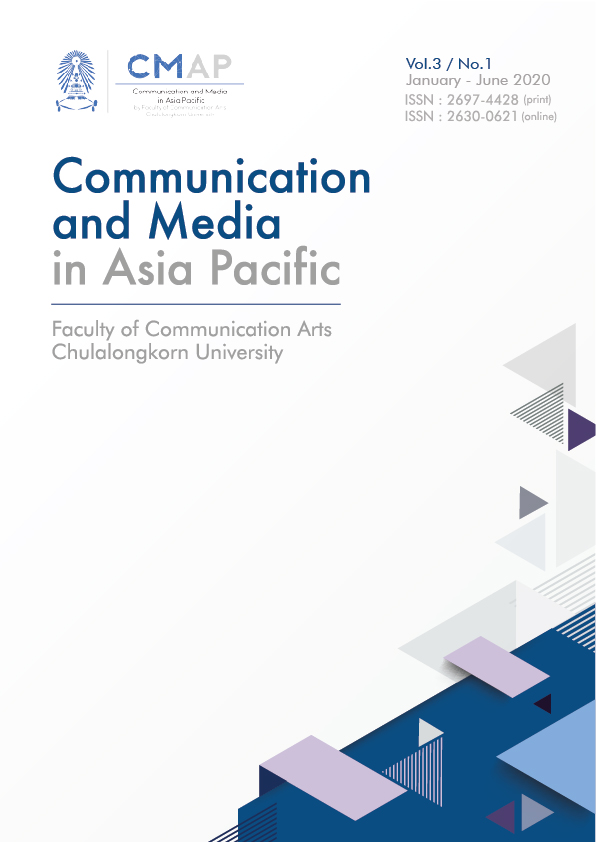Revisiting Discursive Interface Analysis for the Study of Digital Advertising in Asia
Main Article Content
Abstract
This paper revisits discursive interface analysis to explore the possibility of having a universal method to scrutinize the power, creativity, and freedom of digital media through digital advertising. This is due to the facts that i) there is commercial success in and high potential of digital advertising; ii) digital advertising is a representation of digital media; and iii) digital advertising often embraces the latest technologies and the innovative use of digital media. It specially explores the suitability of discursive interface analysis for this study through ten digital advertising campaigns in Asia. The analyses show that there are insufficiencies in the sensory, cognitive, and functional affordances of discursive interface analysis for the study of digital advertising. The paper concludes with a revision of these three affordances to reveal the power, creativity, and freedom of digital media through digital advertising.
Article Details
References
Digital Training Academy. (2014). Heart-warming Thai insurance ad gets 6 million views in a week. Retrieved from http://www.digitaltrainingacademy.com/casestudies/2014/04/ heartwarming_thai_insurance_ad_gets_6_million_views_in_a_week.php
eMarketer. (2018). eMarketer releases new global media ad spending estimates: Digital channels will overtake traditional mediums by 2021. Retrieved from https://www.emarketer.com/content/emarketer-total-media-ad-spending-worldwide-will-rise-7-4-in-2018
GlennTan. (2016). ShanghaiPRIDE 2015 – Love is our future. Retrieved from https://vimeo.com/159158117
Hung, E. C. K. (2017a). An investigation of weak ontology for new media studies. In International Conference on Applied Human Factors and Ergonomics, pp. 126-131. Springer, Cham.
Hung, E. C. K. (2017b). Towards a generalization of new media. In International Conference on Applied Human Factors and Ergonomics, pp. 89-94. Springer, Cham.
Hung, E. C. K., Chan, A., & Chan, R. (2018). A study of rules, structures, features, and biases in the new media for digital advertising for the development of new media ontology. In International Conference on Applied Human Factors and Ergonomics, pp. 88-92. Springer, Cham.
Hung, E. C. K. (2019). An exploration of the creative work ontology for the ontology aggregation of social media. Journal of Communication and Media in Asia Pacific (CMAP), 2(1), 37-50.
Kaul, V. (2017). Intercultural communication and new media. International Journal on Transformations of Media, Journalism & Mass Communication, 2(2), 10-22.
Koe, T. (2018). Nestlé Japan aims to increase online sales to 20% via ambassador schemes. Retrieved from https://www.foodnavigator-asia.com/Article/2018/07/03/Nestle-Japan-aims-to-increase-online-sales-to-20-via-ambassador-schemes
Lamerichs, J., & Te Molder, H. F. (2003). Computer-mediated communication: From a cognitive to a discursive model. New Media & Society, 5(4), 451-473.
Lister, M. (2009). New media: A critical introduction. Taylor & Francis.
Liu-Thompkins, Y. (2019). A decade of online advertising research: What we learned and what we need to know. Journal of Advertising, 48(1). 1-13.
Malthouse, E. C., & Li, H. (2017). Opportunities for and pitfalls of using big data in advertising research. Journal of Advertising, 46(2), 227-235.
Mobile Marketing Association. (2013). Coca-Cola: Coke PLAY. Retrieved from https://www.mmaglobal.com/case-study-hub/case_studies/view/27196
Mobile Marketing Association. (2015). Samsung Vietnam: Watch it with the S6. Retrieved from https://www.mmaglobal.com/case-study-hub/case_studies/view/41289
Mobile Marketing Association. (2016a). Horlicks: Nutriquest. Retrieved from https://www.mmaglobal.com/case-study-hub/case_studies/view/42549
Mobile Marketing Association. (2016b). Nike: Kobe-mojis. Retrieved from https://www.mmaglobal.com/case-study-hub/case_studies/view/42560
Mobile Marketing Association. (2016c). Singapore Airlines: Multi-device app. Retreived from https://www.mmaglobal.com/case-study-hub/case_studies/view/42569
Mobile Marketing Association. (2017). The closet you can get to your customers. Retrieved from https://www.mmaglobal.com/case-study-hub/case_studies/view/46653
Norman, D. A. (2013). The design of everyday things: Revised and expanded edition. New York: Basic Books.
Punch, P. (2016). Sun Life Stanley International Dragon Boat Championships 2016: Interactive game booth. Retrieved from https://www.youtube.com/watch?v=fRmi0c1xTPQ
Schlagwein, D., & Hu, M. (2017). How and why organisations use social media: Five use types and their relation to absorptive capacity. Journal of Information Technology, 32(2), 194-209.
Stanfill, M. (2015). The interface as discourse: The production of norms through web design. New Media & Society, 17(7), 1059-1074.
Sundar, S. S., & Limperos, A. M. (2013). Uses and grats 2.0: New gratifications for new media. Journal of Broadcasting & Electronic Media, 57(4), 504-525.
Truong, Y., McColl, R., & Kitchen, P. (2010). Practitioners’ perceptions of advertising strategies for digital media. International Journal of Advertising, 29(5), 709-725.


